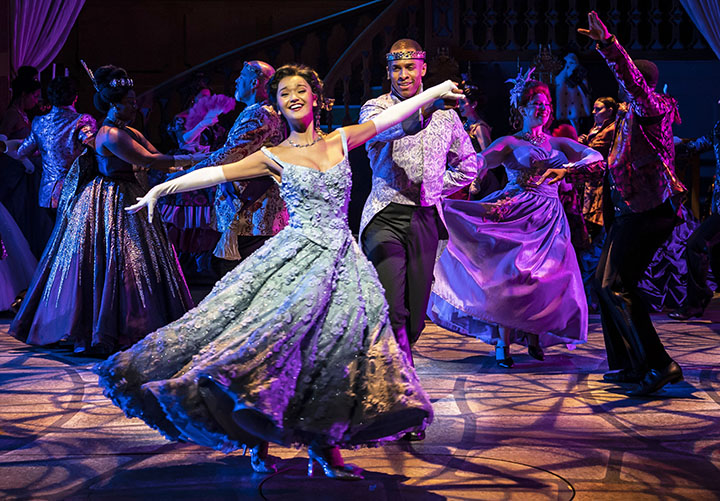Unlike many young children, Mikayla Renfrow never dreamed of growing up to become a princess. She never saw herself represented in any of the standard Disney princess films. It was not until she watched the 1997 Cinderella adaptation with Whitney Houston and Brandy that she truly saw someone – Prince Christopher played by Paolo Montalban – who looked like herself in a fairytale. Now, as an adult Renfrow, who identifies as an Asian-American woman, wears the glass slippers eight times a week as Cinderella in Rodger & Hammerstein’s Cinderella at the Paramount Theater in Aurora, Illinois.
Color-blind casting is a practice in theatre that refers to the removal of ethnicity, skin color, body type, sex or gender from the casting process. In the last several years, the conversation of color-blind versus color-conscious casting has become more prominent.
New York City-based actress Mikayla Renfrow currently stars as Cinderella at the Paramount Theatre. She received her BFA in musical theatre from the University of Cincinnati College-Conservatory of Music (CCM) last year. Some of her previous theatre credits include Alice in Seven Brides for Seven Brothers and ensemble in Chicago at the Muny in St. Louis, Missouri! She says her first time being exposed to the term “color-conscious casting” in her career was during her sophomore year of college.
“From what I can understand, color-conscious casting is when you make a distinct decision to include and see people and their race so that you don’t do harm or paint a picture that can be problematic or harmful in any way,” Renfrow explained.
Color-conscious casting is the opposite of color-blind casting, and encourages casting directors to consider ethnicity and diversity in order to accurately portray the characters onstage. The American Theater says color-conscious casting is utilized in the arts to “oppose racism, honor and respect cultures, foster stronger productions, and contribute to a more equitable world.”
University of Illinois senior Kyle Krisch is preparing to enter the professional theatre industry next year. He is pursuing a BFA in theatre studies with a focus in directing. Krisch utilizes a color-conscious casting approach when selecting the cast for a show because he says he wants his productions to reflect the real world and genuine circumstances.
“Last semester, I directed Little Women for Illini Student Musicals and I had a Black actress play Jo, though all her sisters were White,” explained Krisch. “So now, in the context of Little Women, Jo has the trauma and life experiences of a Black woman.”
Krisch says he has been part of many important conversations with the Illinois theatre department regarding what voices need to be heard and what stories need to be told in their productions. When asked what he believes is wrong with color-blindness in theatre, Krisch mentioned the lack of accurate representation in live performance.
“Color-blindness goes with the saying ‘I don’t see color’ which ultimately erases color from our vocabulary and from our consciousness,” Krisch said. “With color-conscious casting, you’re able to see roles that are traditionally White represented in a way that is more authentic with the world we’re living in… We are able to acknowledge these roles from a BIPOC (Black, Indigenous, and people of color) perspective.”
When asked for her views on the phrase ‘I don’t see color,’ Renfrow agreed with Krisch: “When people say ‘I don’t see color, I feel like [they’re] erasing a huge part of my identity. It’s making it invisible, which is… not the direction we should be going in,” she explained. “Educate yourself. Read. By understanding experiences other than your own, you are one step closer to making sure you’re not causing any harm to those around you.”
During the audition process for Cinderella, Renfrow explained that director Brenda Didier was seeking someone with similar life experiences as Cinderella to play the leading role. Renfrow says having Cinderella be a woman of color was very important to Didier, as that is someone who can understand what it feels like to be an outsider in the world.
“When we bow, it’s the one time we can really look out into the audience,” Renfrow said. “We see little kids who look like me and Markcus (a Black actor playing Prince Christopher) in prince costumes and Cinderella costumes. We always just tear up. It’s so cool to see kids who look like us and know they see themselves on stage because we didn’t really have that growing up.”
Renfrow says her advice to young actresses is to do everything. She says to never miss out on an opportunity to learn and to be hungry for training, classes and further experience in the arts.
Actor and educator Joe Hoyt runs the Joliet Central Drama Program at Joliet Central High School in the southwest suburbs of Illinois. He directs and performs in local productions and serves as an acting coach to his wife and children who are all professional actors represented by Gray Talent Agency. Hoyt comments on the universal messages in theatre that allow characters to be portrayed by a variety of actors who share the story through different perspectives.
“There are so many stories that are told onstage and onscreen that can easily be an experience that is not limited to one race or one culture,” Hoyt said. “It is important that those stories be told through many different lenses to make people understand that that can be anyone’s story. As someone who teaches at a majority minority student school, I want my students to know that most stories have universal messages that any person can relate with.”
With two children actively pursuing professional acting, Hoyt says he and his wife have had many difficult conversations with them regarding casting in theatre. He describes equity in theatre as a pendulum, and says that the pendulum is currently swinging in favor of minority actors: “What [my children] started to find was that every time we got close to something, when we saw who was cast – whether it was a play, tv show or movie – it was always a minority actor. We have conversations about how things used to be, when minority actors didn’t get cast in anything. There is always going to be a pendulum swing, and right now, the pendulum has swung in favor of a lot of color-blind minority casting. That’s a good thing!”
In 2017, the Asian American Performers Action Coalition noted that 29% of the performers on Broadway stages were Black, Asian or ethnically diverse, a 7% decrease from the previous year. As an acting teacher, Hoyt says he actively seeks out materials that reflect the identities of his students in a positive way.
“It’s important that right now many of the stories we’re telling are Black experience stories, Brown experience stories, cultural experience stories,” Hoyt explained. “We take stories that are typically told through the lens of White America and tell them through a mixed lens. People are starting to realize that the messages of theatre, film and television are universal messages.”
By selecting productions that allow for diverse casting, Hoyt says his pool of auditionees to choose from for each role grows larger. When casting a production, he says it is important to stay true to the message of the play, in order to assure that the portrayal is respectful and maintains the vision of the playwright.
“There are certain plays that deal with certain topics or time frames that require color-conscious casting,” Hoyt said. “For example, if you were to do a play like Raisin in the Sun and decided to create a more modern version, where the White cast is the minority, that’s not staying true to the message of the play. Color-conscious casting is important to maintain the integrity of the stories that are being told so that directors don’t take so much creative liberty that they’re making their own interpretation of the production.”
Kyle Krisch says that as the conversation of color-conscious casting in theatre becomes more prominent, he intends to use his position to raise awareness and amplify underrepresented voices. He says this extends far beyond ethnicity and skin color: “The theatre community has taken strides in the right direction in the sense that we have artists playing non-traditional roles,” Krisch said. “It’s important to understand that just because someone looks a part, that does not necessarily mean they understand a part. It extends to other stuff like body type, and queer versus non-queer actors portraying LGBTQ+ stories.”
When discussing the impact of accurate representation left on audience members, the Coming Together coalition says, “When audiences and artists reflect the universality of humanity, ALL thrive. When the opposite happens – when stories are appropriated by the inauthentic, there is loss, pain, misconception, misunderstanding, fear and aggression.”





